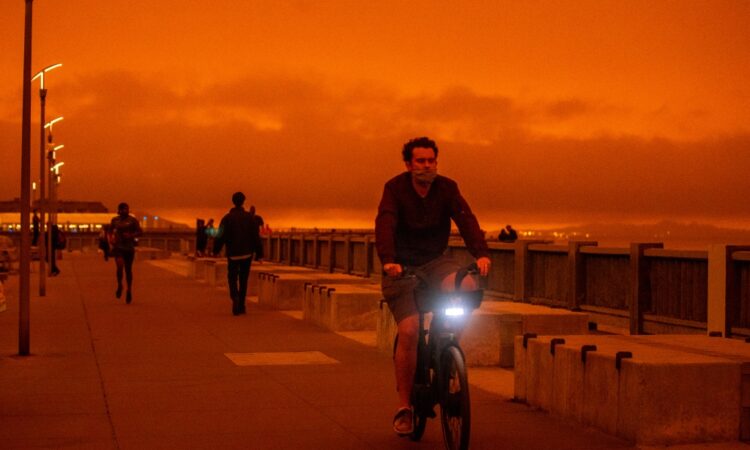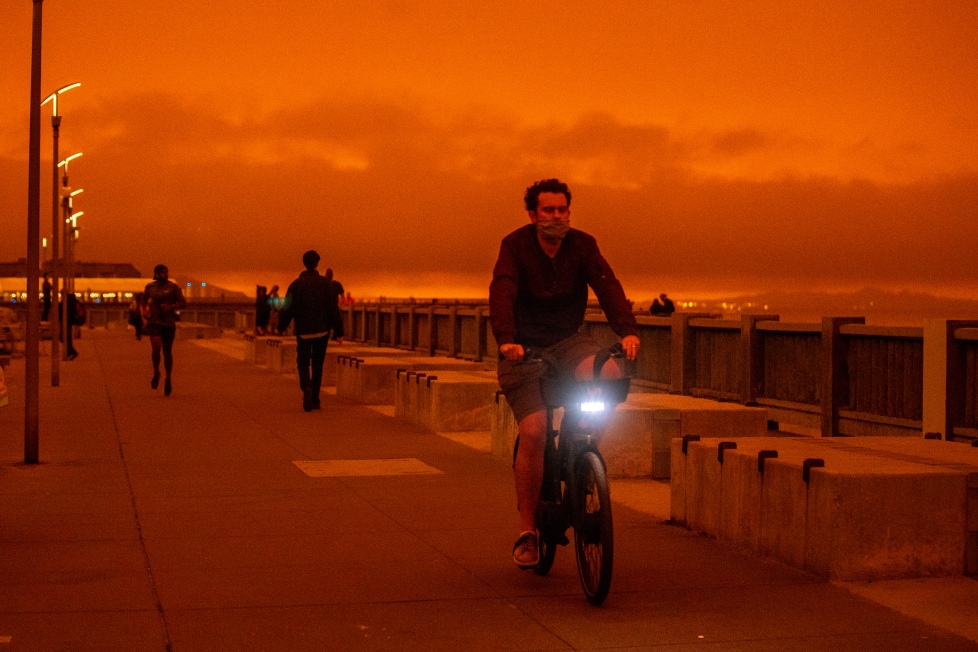

People walk and ride along the Embarcadero as smoky skies from the Northern California wildfires casts an orange and yellow color in San Francisco, Calif., on Wednesday, Sept. 9, 2020. (Ray Chavez/Bay Area News Group)
Massive forest fires. Deadly floods. Record heat waves. Historic droughts.
Over the past decade, California has repeatedly experienced the destructive impacts of climate change — “weather on steroids” — costing billions of dollars in damage and claiming dozens of lives.
Now, in what may be the largest environmental measure ever placed on a state ballot in California, lawmakers in Sacramento are drafting a $15 billion “climate bond” for next year’s elections to test whether voters are willing to open their wallets to harden the state’s defenses.
Two similar bills are moving forward in the Legislature, with broad support from the Democratic majority and Gov. Gavin Newsom.
Both would provide significant new funding to thin forests, boost flood control projects, plant trees to cool cities, expand renewable energy, and take other steps to deal with a climate that scientists say will continue to warm for generations to come.
“This is a first-of-its-kind attempt in California to create a statewide response to climate change,” said Sen. Josh Becker, D-San Mateo, co-author of one of the bills. “This winter we saw the effects on floods. Highway 84 in my district is still out. We were all affected by wildfires a couple of years ago when we had the orange skies. There’s no part of the state that is untouched.”
In a PPIC poll last July, 72% of registered voters in California said the impacts of climate change are already underway in the state. That included 81% of Democrats, 73% of independents and 45% of Republicans.
But will voters approve money to reduce the impacts of climate change?
Last November, voters in New York state approved a $4.2 billion climate bond by an overwhelming 67%-33%, giving a road map to California lawmakers writing a West Coast version.
The New York measure, endorsed by Gov. Kathy Hochul, will fund a wide variety of projects. Among them: flood control to address rising sea levels in areas like New York City and Long Island Sound; renewable energy; expanded parks, farmland and open space preservation; and other efforts, including purchasing zero-emission school buses and opening urban cooling centers during heat waves.
“That was an encouraging sign,” said Jerry Meral, a former deputy secretary of the California Natural Resources Agency under Gov. Jerry Brown.
Most parks and water bonds in California have passed since 1928, Meral noted, when voters approved a $6 million measure to create the modern state parks system. Those funds purchased old-growth redwoods on the North Coast, parts of Mount Diablo and sandy beaches that today are enjoyed by millions of people.
But there are warning signs also for supporters of putting a climate bond on California’s ballot.
In March 2020, Proposition 13, a bond measure that would have raised $15 billion for preschools, K-12 schools, community colleges and state universities, was rejected by voters, 55-45%.
Some political observers said the failure was because its name — Proposition 13 — caused confusion with the famous 1978 ballot measure of the same name that cut property taxes. But others said that the price tag was just too big.
“I’m still traumatized by that. It scares the hell out of me,” said Meral, who was the chief author of another measure, Proposition 3, an $8.7 billion water bond, that voters narrowly defeated. “That had a strong campaign, and it still failed.”
Generally speaking, most of California’s largest environmental groups are lining up behind the two climate bond bills, SB 867, by Sen. Ben Allen, D-Redondo Beach, and AB 1567, by Assemblyman Eduardo Garcia, D-Coachella.
Green groups were angry that Newsom reduced the size of his five-year climate change plan, from $54 billion last year to $48 billion this year, to help close the state’s budget deficit. They see the bond as a way to make up for those cuts.
California’s state parks are also in need after taking a huge hit during the massive storms this winter. There was at least $210 million in damage to state parks across California. President Joe Biden visited the wreckage of Seacliff State Beach, where the campground and pier were destroyed, and parks in Big Sur whose trails and bridges remain closed.
The state parks system has a $1.2 billion backlog of deferred maintenance, and a climate bond could help reduce that while boosting flood control and reducing fire risk, said Paul Ringold, conservation director of Save the Redwoods League in San Francisco.
“Climate change is not going to be happening after you are dead,” he said. “It is happening right now. We are seeing the impact with record wildfires, and record temperatures. The more we can do right now to address the impacts the better for us now and for future generations.”
But critics say the state shouldn’t borrow to fund such programs.
Bonds are like loans. Corporations, states, cities, local governments and the federal government issue them to raise money, and investors buy them. The investors are repaid with interest over time, similar to the way that a homebuyer receives a mortgage from the bank and pays it off over many years with interest.
“There’s a completely separate issue from what the projects are and whether they are needed and how to pay for them,” said Susan Shelley, spokeswoman for the Howard Jarvis Taxpayers Association in Sacramento. “Bonds are the most expensive way to pay for things. It’s double the cost of pay-as-you-go because of the interest. They would be saddling people with debt for 30 years to pay for these programs.”
Newsom and legislative leaders will have to finish the language of the bills, merge them into one package, and decide which ballot — March or November — to place the measure on, by the last day of the legislative session Sep. 14. Other bond measures for housing and homeless issues also are competing for funding and ballot space.
But last month, Newsom said placing a climate bond on the ballot is a priority for him. He said expanding renewable energy and electric cars is helping California lead an industry of the future, and that the state can only expect more natural disasters in the years ahead.
“What more evidence do we need on climate than what we’ve had to experience with this weather whiplash in the state of California?” he said. “From three years with the driest of dries, to a three-week period with the wettest of wets. Back to back. It’s just extraordinary. You don’t have to believe in science. You can believe in your own lived experience.”






